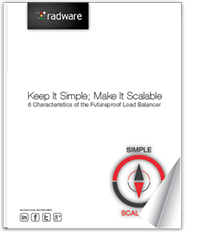The Future of Application Delivery: Hyper-Convergence, Micro-Services AND On-Demand?
I am one of those people that like the concept of instant gratification when shopping. I like that I can purchase something, and immediately hold it in my hands and use the item, whether it is a piece of technology or a cooking accessory. This is not unlike what customers expect when they want to access an application on the network.
We live in a hyper-converged, micro-service driven, and on-demand world. You may agree with that statement, but do we really understand what it means? From an IT perspective, it means that we are delivering services or applications based on individual, custom-tailored requirements (micro-services). They are provided through a common pool of compute, storage, and network resources (hyper-converged). Last, the customized application instances are brought up and made available when needed and only when needed (on-demand).

Customized Application Delivery
Load balancing and application delivery controller (ADC) services help deliver the applications throughout the infrastructure. They ensure that there is proper connectivity between the client and the application. When we look at spinning up these specialized application instances, it makes sense that we need to provide the application delivery infrastructure to deliver these applications reliably and securely.
The dynamic nature of this environment and architecture is not designed for proprietary and fixed hardware-based technologies. The application delivery platform needs to have the flexibility to be brought up and down along with these applications which are constantly being created and disassembled.
[You might also like: The Maturing of ADC Technology – Moving Beyond Load Balancing]
Virtualization and Isolation
This means that the ADC technology needs the flexibility to be brought up as a virtual instance along with each application instance. These virtualized instances can be partitioned within the ADC platform or separate software-based virtual appliances. In both cases, it is important that the ADC services are self-contained within this instance from a resource consumption perspective. It is imperative that the ADC instance does not have any detrimental impact on any other instance or service running on the services infrastructure.
In the same light, security policies need to be applied and associated with the application delivery infrastructure. As I have discussed before, the ADC plays a very important role in the implementation of security policies for applications. When the ADC is virtualized, the security policies must be applied to the ADC services. These policies cannot have any impact on any other application or virtualized instance running in the same architecture.
If we take a look at this environment and the requirements for ADC services in this hyper-converged, micro-service driven, and on-demand architecture, we can come away with several key requirements:
- The virtualized ADC technology must have the density to support a micro-services environment
- There needs to be true resource and security policy isolation to play nicely in the hyper-converged infrastructure
- The ADC framework must support management and orchestration including automation to work efficiently In the dynamic on-demand ecosystem
All of this is important because the network infrastructure is becoming software driven and customized as organizations move towards virtualization technologies to optimize the capital and operational costs to support the IT infrastructure. Customers expect this evolving flexible ecosystem and businesses need to architect a solution that can adjust to their changing demands over time.




